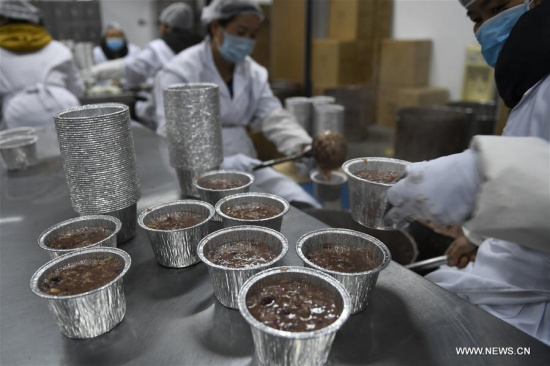
Voluntary workers fill bowls with Laba porridge at the Lingyin Temple in Hangzhou, east China's Zhejiang Province, Jan. 23, 2018. (Xinhua/Huang Zongzhi)
Wednesday marks the Laba Festival in China, a prelude to the traditional Spring Festival, which falls on the eighth day of Layue, the twelfth and last month of the Chinese lunar calendar. In the cold weather, the festival is godsend – a blessing in a bowl of rice porridge.
For days now, people in the eastern Chinese city of Hangzhou, Zhejiang Province, have been queuing up outside the Lingyin Temple, waiting patiently for a hot bowl of Laba congee to warm them up as temperatures go down.
The distribution of the congee begins on the first day of the month and lasts until midday on Laba Festival – this has been the tradition since 2008 after the custom was restored.
But what is so special about the ceremonial congee that people brace the winter wind for a ladle of the chunky soup?
A flavorful history
The Laba Festival is traditionally a ritual to worship the ancestors and gods. The Chinese character "La" means the transition from the old to the new, and Layue is the month when people present their harvested food at altars.
The festival was later influenced by Buddhism and the eighth day of the last lunar month was set during the Southern and Northern Dynasties (420-589) to celebrate it, coinciding with the enlightenment day of Buddha.
The tradition of eating Laba congee during the festival could be traced back to the Song Dynasty (960-1279). From the imperial court to ordinary people, cooking the congee was a seasonal must. They not only cooked the dish for their own family members, but also sent it to others as a gift.
The Laba Festival was also a day of charity. Wealthy families would prepare a huge pot to cook the congee and distribute it to the poor. It is also during that time that Buddhist temples began to offer Laba congee to their visitors.
The congee's components
Part of the reason why people are crazy about the congee is because of its richness in nutrients and delicious flavor. Traditionally, the congee is made with rice, beans, peanuts, dried fruits and lotus seeds. Flavor aside, some of the ingredients have profound connotations in Chinese culture.
For instance, red beans represent the feeling of longing for the beloved, while lotus seeds are believed to carry the meaning of fertility. Jujubes are auspicious, while longans (also known as dragon's eyes) depict prosperity and wealth.
All the ingredients are carefully rinsed and soaked in clean water for hours, and then boiled for a whole night. In the past, people would boil the mixture the night before the festival and heat it on low fire the next morning.
However, family members would never be the first to taste the congee. It was usually presented to the ancestors at the altar first, and then part of it would be sent to the neighbors, relatives and friends. It's a virtue in traditional Chinese culture to put others before oneself.
After sharing the porridge with others, a family can finally sit down and enjoy a bowl of the steaming hot congee. The dish tastes even better with Laba garlic – vinegar-preserved garlic that balances sour and spicy flavors.
Although some of the festival's traditions have gradually faded, Laba congee is still loved and longed for by many Chinese people.
The distribution ritual of the congee has also been preserved. Temples as well as restaurants cook and hand out Laba congee on the day of the festival to sanitation workers and senior people who live alone.
More than just a bowl of porridge
In recent years, many traditions that were slowly dying out have been restored, as local governments around the country push forward with the rejuvenation of the Chinese culture. The Laba Festival rituals of the Lingyin Temple were listed as a local intangible cultural heritage at the end of 2017.
Distribution of Laba congee is not confined to the Lingyin Temple, but Buddhist worshiping places around the country serve up the warm porridge. In Beijing, the Yonghegong Lama Temple and the Tanzhe Temple are the go-to places for Laba congee.
Every year, thousands of people line up there since the early morning for the bowl of goodness, looking for nothing more than having good luck in the year to come and sharing with others the warmth of giving and receiving in the cold winter.


















































